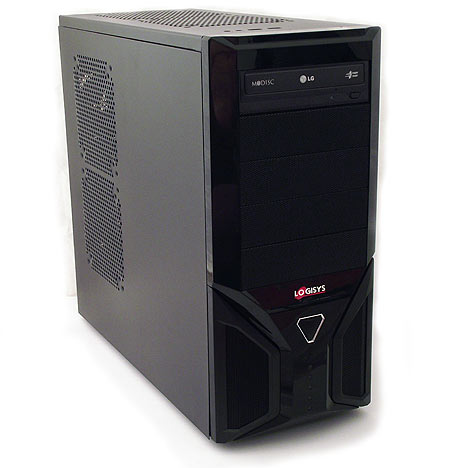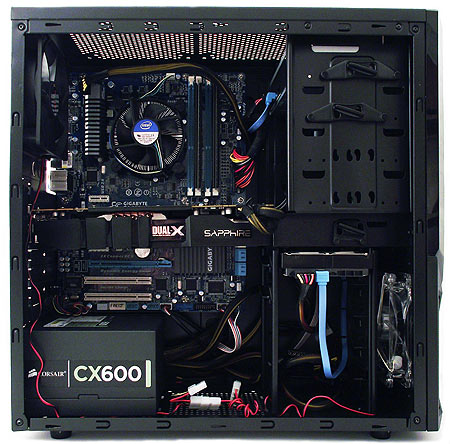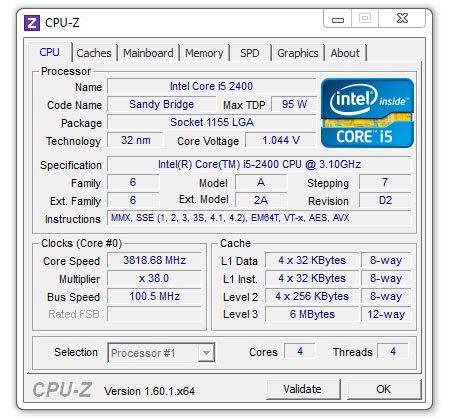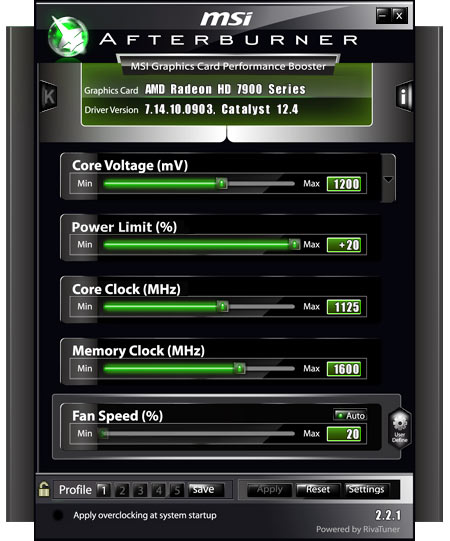System Builder Marathon, June 2012: $1000 Enthusiast PC
System Assembly And Over-Clocking
We ran into two issues as we were putting this system together.
First, the motherboard’s rear I/O panel cover doesn't line up with the USB and PS/2 ports on the far left. We’re not sure why. It seems like the holes aren't placed perfectly, and we suspect the recess on the Logisys Optimus II case isn’t square with the motherboard. Whatever the cause, we had to install our motherboard without its panel in place (irritating for the perfectionists on our crew).
Secondly, we had a problem fitting the huge Sapphire Radeon HD 7970 OC into our case. It can be made to fit, and it does work. But the very end of the cooler's shroud pushes against the chassis, and we’re not comfortable with that. If you plan to buy this extra-long and extra-wide graphics card, take some measurements first to make sure it fits inside the chassis of your choice.
Overclocking
In our last mid-range build, we were unable to force the Core i5-2400’s maximum 38x multiplier due to BIOS limitations. Gigabyte's P67X-UD3 doesn’t suffer from those same constraints, though it turns out that the difference is mostly theoretical.
We were able to set a 38x ratio. However, it's only used in single-threaded workloads. In fact, we found it very rare for our build to run at 3.8 GHz at all, even when Prime95 was set to push a single core. It instead bounced between 3.6 and 3.8 GHz. We turned off CPU thermal monitoring in the BIOS and increased the Turbo Boost power limit to 200 W, but those changes yielded very little benefit. The only way to get 3.8 GHz reliably was to set processor affinity to a single core in Windows' task manager. Applications optimized for two or three threads tended to run at 3.7 GHz, and any software able to exploit all four cores ran at 3.6 GHz.
Because our application suite is heavily threaded, we expect to see very little difference between the new results and the ones from the previous build, although we're still hoping that the additional memory bandwidth attributable to a second channel will help in some instances. Then again, losing the SSD probably won't help this quarter's build.
Get Tom's Hardware's best news and in-depth reviews, straight to your inbox.
Sapphire’s Radeon HD 7970 OC proves to be fairly tunable, although the newest version of the company’s Trixx overclocking utility has some problems. We ended up with a maximum core overclock of 1125 MHz and a memory frequency of 1650 MHz, achieved with a 1.2 V setting in MSI's excellent Afterburner tool.
Current page: System Assembly And Over-Clocking
Prev Page Memory, Hard Drive, And Optical Drive Next Page Test System And BenchmarksDon Woligroski was a former senior hardware editor for Tom's Hardware. He has covered a wide range of PC hardware topics, including CPUs, GPUs, system building, and emerging technologies.
-
ddan49 I personally think they went a little TOO overboard on the GPU. Sure, it'll tear through games... but at 4GB of RAM, a non-overclockable i5 CPU, and a P67 motherboard... well... meh...Reply -
ddan49 ReplyWe have two very similar systems here, and the new one has to make due with 4 GB less RAM, no SSD, and no aftermarket CPU cooler.
May want to put "do" in there, instead ;) -
mayankleoboy1 not criticizing, but this build looks like a half-hearted attempt.Reply
Basically the whole article tests the improvements of a single channel over a dual channel RAM. -
mousseng I realize the SBM is sponsored by Newegg, so that means they're only able to get what they can from Newegg?Reply
Because if not, I would posit that the i5-2380p is a better CPU choice than the i5-2400:
1) You've not got a huge need for the IGP, what with the 7970 (I could see it could still have use, but I don't think it would be that helpful)
2) From what I've read on Newegg's page for the 2380p (which they no longer sell), the 2380p is a great overclocker (up to 4.5Ghz according to one reviewer)
3) It costs the same as the 2400, with the same stock clocks
Apart from that, I think it's a pretty solid build. A little too much corner-cutting compared to what I would've chosen, but I'd probably put together something rather standard and boring. -
pistolpete31 mayankleoboy1not criticizing, but this build looks like a half-hearted attempt. Basically the whole article tests the improvements of a single channel over a dual channel RAM.Reply
Yeah I totally agree, I would have loved to see a 3570k and a gtx 670 because those two seem like the popular choice right now. Who sets this budget anyways? "We didn't wan't to go over" umm is there like a slow painful death if you go over the budget or what? Set the budget higher then. Hope the next round of these is better. -
koshadows I'm not quite sure how I should respond to both of the system builders comment section from this week. Gtx 670 wasn't available, we know. Stop beating this dead horse. Its just like last quarter's waterfall of "why no 680????"Reply
As of right now at the time of this post, the sapphire 7970 o/c on newegg is at $480. http://www.newegg.com/Product/Product.aspx?Item=N82E16814102982 So i can only assume whatever price hike has been dealt with?
Good job on making a computer perform about the same for $250 less! I'm sure if I was to build a computer right now this would give quite a bit of breathing room. Not everyone has quarter of a grand to throw around.
Downside is it does feel like you guys ran outta ideas on new combinations. I think I'd be kind of interested in either a SLI config 560 ti or 7850s. But the 7850 would've pushed it past budget I think. I'd still vote on the SSD though!




